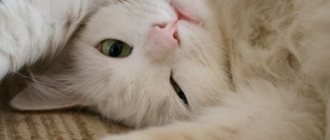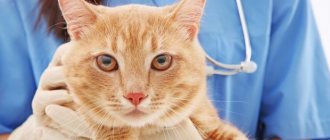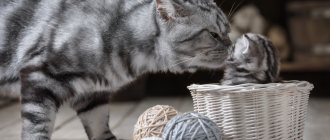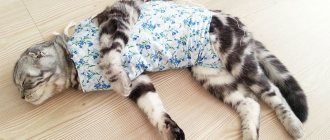Sterilizing a cat stops the production of sex hormones, as a result of which its sexual activity subsides. Surgery is stress for the animal, which must be reduced as much as possible so that it does not provoke the development of secondary pathological processes.
In addition, a sterilization operation involves a violation of the integrity of the muscle tissue and skin of the animal, which requires special care, a long period of rehabilitation and regular treatment of the surgical suture. If the operation was performed by a qualified doctor, then serious complications should not be observed.
In any case, the owner must be prepared for possible problems that will need to be resolved immediately. Let's look at how to avoid them and what to do if the cat licked the seam after sterilization or it unexpectedly came apart.
A cat licks a wound after castration: causes, consequences
Castration of animals is a simple surgical operation that involves removing the gonads in males and stopping reproductive functions. The operation is performed in a veterinary clinic or at home under general or combined anesthesia. If all rules are followed, animals do not experience any serious complications after castration. Moreover, the duration of the postoperative period largely depends on the correct actions of the owners. After the procedure, you need to pay attention not only to the health of the fluffy, but also to monitor the condition of the postoperative area. If a cat licks himself after castration and does it furiously and intensely, sutures may come apart. Bacteria can enter the wound, causing suppuration and causing acute inflammation.
Reasons for concern
For 3 days after surgery, the owner’s main task is to ensure that the animal cannot lick the postoperative suture. It is important to understand that it will take 10-20 seconds for the animal to remove the threads and injure itself. The best option is to put a blanket on the cat immediately after the operation, which must be worn until the suture heals.
If it so happens that your cat has licked the stitch, as a result of which it looks swollen and red, you need to do everything possible to dry the wound. To do this, you need to follow the following recommendations:
- Do not apply a bandage or adhesive plaster to the postoperative suture, as they do not allow air to pass through.
- To reduce swelling and get rid of redness, the seam should be treated with levomekol or another similar drug.
- It is necessary to put a blanket on your pet and make sure that he does not remove it as long as the wound heals.
- The cat owner must ensure that the post-operative suture remains clean.
If the animal’s base body temperature has increased or inflammation has increased, you should immediately contact a veterinarian.
What you need to know about castration
Castration is a simple and quick operation that takes no more than 20-30 minutes. But as after any surgical intervention, in order for the postoperative recovery period to pass without complications, the cat needs careful, delicate care and care.
Important! Any operation is a strong stress for the animal’s body, which can affect the condition and behavior of the pet.
If the operation went well, after about 30-40 minutes you will be able to take your pet home. Take care of a carrier, a basket, at the bottom of which place a disposable sterile diaper, clean flannel, or any other waterproof fabric. It is better to transport your cat not in public transport, as this can cause additional stress, but in a taxi or personal car.
Pyometra
Unfortunately, it is a very common disease.
Diagnosed only by veterinarians. For an experienced doctor, a thorough examination with an x-ray (or ultrasound) is sufficient. Test results indicate the form of the disease and help to more accurately determine what antibiotics are needed in each specific case. If your cat has been diagnosed with pyometra, know that surgery is not always the only option. Sometimes conservative methods can also have an effect: droppers, hormones, antibiotics (Enrofloxacin and Amoxicillin are most often used). Find out if this solution is suitable for your case. But the verdict must still be made by the veterinarian. Please note: self-medication is unacceptable here, and slowness in making a decision can cost your cat’s life.
Why does a cat lick itself after castration, reasons
As already noted, castration, like any other operation, is highly stressful for animals. The duration of the adaptation and recovery period depends not only on the individual characteristics of the body, but also on proper systematic care.
After the operation, the cat experiences pain and discomfort in the first days, getting used to its new condition. If you notice that your cat constantly licks his genitals, this method eliminates unpleasant symptoms.
Another reason for this behavior can be called postoperative shock. The pet does not understand what happened to him. In addition, visiting a clinic or changing your usual environment always provokes stress. Therefore, we do not recommend leaving your pet unsupervised in the first few days after the procedure. During this period, the animal needs your attention, affection and care more than ever. Protect your pet from stress, do not scold the animal for wrongdoing, create the most comfortable conditions for the fluffy.
Is it possible to lick a wound?
Despite the fact that the saliva of our little brothers contains enzymes and substances that accelerate healing and tissue regeneration, it can also contain pathogenic microorganisms that will lead to the development of acute inflammation, suppuration, and infection. If a cat licks a wound, the natural healing process is disrupted.
In addition, the rough tongue of felines, especially with frequent intensive licking, can lead to sutures coming apart and bleeding. If a cat licks itself, treatment with antiseptics and disinfectants will not give the desired result and will increase the rehabilitation period. Therefore, you need to constantly monitor the cat and monitor the condition of the wounds daily.
Inspect the scrotum for signs such as redness, tenderness, and swelling. If blood oozes from the wound, severe bleeding has developed, the stitches have come apart, or greenish-yellow exudate is released, immediately contact your veterinarian and take your pet to the clinic. Make sure that no dirt gets into the wounds. If, for example, the postoperative area is contaminated with feces, clean the wound with warm water and a weakly concentrated solution of betadine. Dry the seam and lubricate it with antibacterial ointment.
Important! After surgery, consult with your surgeon regarding proper care.
If, in addition to licking, the cat shows restlessness, rushes around the apartment, tries to hide in dark secluded places, constantly meows pitifully and this behavior lasts more than two days, consult a veterinarian. It’s better to play it safe once again than to correct serious consequences later.
Nuances of postoperative care
After castration, the cat needs to be properly cared for. The owner’s task includes not only treating the wound and preparing the correct diet, but also other equally important responsibilities on which the recovery process of the pet cat will depend.
Can a cat lick a wound?
The cat should not be allowed to lick the operated area. This can lead to sutures coming apart, bleeding, and wound infection. That is why it is recommended to wear a special collar, which can only be removed during meals under the watchful supervision of the owner.
Why can't you jump after castration?
In the first hours after the operation, the owner should monitor every movement of the cat, which has not yet recovered from anesthesia. The effect of anesthesia disrupts coordination of movement and disorients in space. Jumping from a height should not be allowed; the cat may not calculate the distance and trajectory of the jump, which will lead to a fall and injury to the operated area.
After surgery, if possible, the animal should be prevented from jumping from heights and active play for the entire period of rehabilitation, until the wound is completely healed.
When can you wash your pet?
Experts do not recommend bathing a cat during the first month after castration. Bath procedures should be avoided for at least 10-14 days after surgery until the wound heals. In case of urgent need, you can clean the fur from dirt using special products or wet wipes.
What else can and cannot be done after surgery
Let's consider what other rules of care should be followed in the postoperative period and what is unacceptable to do after castration of a pet.
Recommendations for caring for a cat after castration:
1. Upon returning home after the procedure, the cat should be placed in a special carrier or placed on the floor where there are no drafts.
Do not place the carrier on high places or near heating appliances. 2. Place a tray and a bowl of water next to the cat’s bed. 3. In the first days after surgery, you need to monitor the cat’s body temperature and monitor the condition of the wound. 4. You should not let your pet outside in the first week after surgery. 5. If necessary, if the cat experiences pain after castration, you can give him painkillers as prescribed by the veterinarian. 6. If signs of postoperative complications are detected, the cat should be immediately shown to a veterinarian! By following these simple rules for caring for a domestic cat during the postoperative period, you can eliminate the risks of adverse effects of castration and significantly speed up the animal’s recovery process. Within 1-2 weeks, the cat will return to its normal life, and the owner will notice many positive changes in his behavior and character.
Postoperative area care
To prevent the cat from licking the wounds and gnawing on the stitches, after the cat has recovered from anesthesia, put on a protective cone (Elizabethan collar) for the pet. A similar accessory can be purchased at a veterinary clinic, pet stores, or veterinary pharmacy. If desired, you can make the collar yourself using cardboard, flexible durable plastic or thick fabric. Give preference to durable material, since the cat will try to pull it off in every possible way.
To ensure that the collar does not cause discomfort to the cat or hinder movement, it must be suitable for the pet in size.
You can also protect the postoperative area from licking by using baby diapers (for newborn babies). For convenience, cut a hole for the tail.
To speed up the healing process, treat wounds with antiseptic and disinfectant solutions . You can use hydrogen peroxide, furatsilin, anti-inflammatory, antibacterial, wound-healing liniments, ointments, gels.
To normalize the general condition, the veterinarian may prescribe a special diet, vitamin and mineral complexes, and hormonal medications.
Reasons for this behavior
How a pet endures the adaptation period after castration and recovers from anesthesia depends on the characteristics of its body and character. Animals, like people, can react to shocks in different ways. You also need to take into account that the cat does not understand what is happening and may be shocked the first time after the operation. During this period, he needs special attention and care.
Some pets, as soon as they recover from anesthesia, immediately return to their usual rhythm of life and do not show much concern. Others, on the contrary, may be stressed for several days.
In addition, there may be other manifestations of the animal’s anxiety - for example, plaintive meowing or attempts to hide from people in a secluded place.
Appetite, thirst and natural functions
After sterilization, the cat's appetite should appear within the first 2 days. This is largely facilitated by painkillers. Fasting for more than 5 days is a sign of ill health and requires consultation with a doctor. Appetite and thirst should reach the same level as before castration. Many owners immediately wonder about changing the diet for their cat to a diet intended for cats after castration.
Remember, it is not recommended to change anything in the diet for the first 10 days for a favorable completion of rehabilitation, because if the cat is skeptical about the new diet, the cat’s malnutrition will not bring anything good. Some cats, after castration, even lose a little weight at first due to changes in the physiology of the body.
It is only necessary to switch to a special diet when you notice that the animal begins to gain weight, and this is noticeable by an increase in fat deposits between the ribs and skin. Sagging belly is not an indicator of obesity. You can also find saggy abdominal folds in thin animals. Focus on the amount of fat deposits between the ribs and skin. It is important to evaluate this no more than once every 2 weeks.
Urination may be less in the first days, especially in the absence of appetite; increased urination, as well as its absence, requires consideration and consultation with a doctor. For painful urethral spasm, follow the recommendations in the paragraph on pain relief therapy.
Consequences
And yet, is it possible for a cat to lick a wound after castration? There are two opinions on this matter. Some people believe that since your pet's saliva has healing properties, you can let him lick himself. However, veterinarians do not advise doing this for the following reasons:
- A rough tongue can damage the castration site, especially with intense licking. There are frequent cases of seam divergence.
- In addition to beneficial enzymes, saliva contains all kinds of microorganisms that can cause infection and suppuration of the wound.
- Treatment with disinfectants and healing agents will come to naught if the cat licks the castration site.
The opinion of experts in this case is supported by weighty arguments, so it is necessary to do everything possible to prevent the animal from harming itself.
Host actions
A natural question arises: what to do if a cat licks itself after castration? First of all, to avoid licking a wound, you need to take care of your pet from a moral point of view. It is important to protect him from stress, not to scold him, to stroke him more often , and to take good care of him. This will allow the pet to calm down a little and stop trying to heal itself.
Of course, it is advisable to use special means to prevent licking:
- Special collar . There are funnel-shaped plastic models on sale, but you can make such a device yourself. The material should be quite rigid so that the cat cannot damage it - for example, thick cardboard will do. A circle is cut out with a hole in the middle. Then an incision is made on one side, and after securing the collar around the cat's neck, it can be sealed with tape or secured in another suitable way.
- Diapers . Regular children's smallest sizes will do. For convenience, a hole is cut in the back for the tail. It must be remembered that you should not keep your pet in them all the time, so as not to infect the castration site. Diapers can be used for a short time at moments when the cat licks the seam after castration especially actively.
Such isolation methods may cause additional inconvenience, but will help to avoid seam dehiscence and the development of infection.
If, in addition to licking, there are other warning signs, you should consult a doctor for advice. Even if the alarm is false, it is better to play it safe to avoid serious consequences for the animal’s health.
Inflammation of the common vaginal lining
A fairly common phenomenon that occurs due to:
- shell detachment;
- administering too much novocaine;
- improper incision of the scrotum;
- blood clots remained after the operation;
- dirt ingress;
- burn of the shell with an alcoholic antiseptic solution.
If you cut the tunica vaginalis to insufficient length, it will not extend upward. The drooping sheets of the membrane form connective tissue adhesions, inside which exudate accumulates. If there is no infection in the cavity, the exudate will resolve on its own after some time. But when bacteria penetrate, purulent inflammation occurs.
Signs of an inflammatory reaction are as follows:
- swelling of the scrotum;
- temperature increase by 1-2°C;
- increased level of neutrophil leukocytes;
- weakness, lethargy, the animal refuses food;
- soreness of the scrotum;
- when palpating, a fluctuation is heard;
- a small amount of purulent exudate may be released;
- the pus is semi-liquid, yellowish, containing fibrin;
- when the adhesion ruptures, exudate comes out in large quantities.
For treatment, surgical opening of the adhesions is used; after removing the exudate, the pain is eliminated, the temperature drops, and the animal quickly returns to normal. The scrotal cavity is treated with antiseptics (3% hydrogen peroxide solution). At high temperatures, antibiotics can be prescribed.
Funiculitis occurs for several reasons:
- contamination of the spermatic cord;
- when the stump falls out of the seam;
- excessively large crush area (with bloodless castration);
- tightening the ligature on the area of the vascular cone;
- coarse threads;
- the area below the sutures is too long.
With an inflammatory reaction in the spermatic cord, a response of granulation tissue in the form of inadequate proliferation is possible. The overgrown granulation tissue forms a granuloma, which is saturated with fibrin. Because of this, the granuloma becomes an irritant of the inflammatory process, as a result the circle closes, the inflammation becomes self-sustaining. As a result, due to random division, granulocytes degenerate into a tumor.
Even if the complication is limited only to ordinary inflammation, without degeneration into a granuloma, it is still very dangerous. Since the inflammatory purulent process can spread along the spermatic cord into the abdominal cavity. As a result, peritonitis and sepsis occur, which can even lead to the death of the pet.
On the first, and on any of the subsequent days, but not after the 5th day, theoretically, a cat after castration may have a body temperature above 39.0 degrees Celsius. The value of this indicator depends on the reactivity of the body, or in other words, on how quickly or strongly it is able to respond to tissue damage, on its sensitivity.
An increase in body temperature does not mean that the animal has contracted an infection, or that the body is becoming infected with a surgical infection. The operation itself is accompanied by tissue damage (skin incision, removal of testes), which leads to the release of inflammatory mediators from the damaged tissues, substances that trigger the body’s protective reaction called inflammation.
After all, it is important to understand that inflammation is primarily a protective reaction of the body aimed at healing. Therefore, an increase in a cat’s body temperature to 39.5 degrees Celsius is absolutely normal. Of course, the animal looks sad, but the use of painkillers will relieve the temperature and improve well-being.
If the temperature is higher than the specified tolerance or occurs after the 5th day, consult a doctor. If you had surgery in a veterinary clinic, and your body temperature rose above 40 degrees Celsius, the first thing you need to do is rule out a viral infection.
The cat licks the seam after castration
Castration of cats Love without consequences. Method one There is probably no person in the world who would not be touched by the sight of little kittens.
However, when purchasing a purring pet, most owners do not want to acquire several more cute creatures every year. In addition, loud calling cries, a pungent smell, marking of “their” territory, aggressiveness, estrus - all these manifestations of cat sexual activity also do not add joy to a person. And therefore, furry owners are looking for different ways to reduce the sex drive of their pets, including resorting to the help of surgeons.
There are two ways to make the breeding process impossible in principle - castration of male cats and sterilization.
Why does a cat lick itself after castration?
Despite the fact that the saliva of our little brothers contains enzymes and substances that accelerate healing and tissue regeneration, it can also contain pathogenic microorganisms that will lead to the development of acute inflammation, suppuration, and infection. If a cat licks a wound, the natural healing process is disrupted.
In addition, the rough tongue of felines, especially with frequent intensive licking, can lead to sutures coming apart and bleeding. If a cat licks itself, treatment with antiseptics and disinfectants will not give the desired result and will increase the rehabilitation period. Therefore, you need to constantly monitor the cat and monitor the condition of the wounds daily.
Inspect the scrotum for signs such as redness, tenderness, and swelling. If blood oozes from the wound, severe bleeding has developed, the stitches have come apart, or greenish-yellow exudate is released, immediately contact your veterinarian and take your pet to the clinic. Make sure that no dirt gets into the wounds. If, for example, the postoperative area is contaminated with feces, clean the wound with warm water and a weakly concentrated solution of betadine. Dry the seam and lubricate it with antibacterial ointment.
Important! After surgery, consult with your surgeon regarding proper care.
If, in addition to licking, the cat shows restlessness, rushes around the apartment, tries to hide in dark secluded places, constantly meows pitifully and this behavior lasts more than two days, consult a veterinarian. It’s better to play it safe once again than to correct serious consequences later.
Features of the operation
A few days before surgery, the doctor examines the animal and takes blood and urine tests. Sterilization is carried out in a specialized veterinary clinic, without the presence of the owner. 12 hours before the start of the procedure, the cat should not be fed; it is only allowed to drink water.
Before surgery, the veterinarian must examine the animal, listen to its heartbeat, observe its breathing and test for allergic reactions.
After the examination, the cat is given anesthesia, and a special tube is inserted into the mouth to stabilize breathing. The veterinarian then makes an incision in or on the side of your pet's belly. After this, the procedure for removing the ovaries and uterus occurs, after which the suture is sutured. The cat is under the supervision of doctors until it emerges from anesthesia.
After the operation, a blanket or Elizabethan collar is put on the animal's neck, which prevents it from licking the wound. Despite the fact that sterilization does not cause severe pain, after the procedure the cat is given an anesthetic injection. Caring for your pet after surgery can be done in a paid clinic or at home.
ATTENTION! At home, your pet will recover much faster, while a hospital setting can cause additional stress for the animal.
If after sterilization you plan to take the animal home, then in the next 10 days you need to give it maximum care. Treatment of postoperative sutures is an important stage in caring for your pet. The most important thing for an animal is complete rest, attention from the owner and care. When looking after your cat, you must strictly follow your doctor's recommendations.
Postoperative area care
To prevent the cat from licking the wounds and gnawing on the stitches, after the cat has recovered from anesthesia, put on a protective cone (Elizabethan collar) for the pet. A similar accessory can be purchased at a veterinary clinic, pet stores, or veterinary pharmacy. If desired, you can make the collar yourself using cardboard, flexible durable plastic or thick fabric. Give preference to durable material, since the cat will try to pull it off in every possible way.
To ensure that the collar does not cause discomfort to the cat or hinder movement, it must be suitable for the pet in size.
You can also protect the postoperative area from licking by using baby diapers (for newborn babies). For convenience, cut a hole for the tail.
To speed up the healing process, treat wounds with antiseptic and disinfectant solutions. You can use hydrogen peroxide, furatsilin, anti-inflammatory, antibacterial, wound-healing liniments, ointments, gels.
To normalize the general condition, the veterinarian may prescribe a special diet, vitamin and mineral complexes, and hormonal medications.
What to do
If you suspect that postoperative sutures are coming apart, you need to soak the bandage with a solution of hydrogen peroxide and carefully remove it. Then you need to perform the following procedures:
- Treat the wound with an antiseptic solution, which will reduce the inflammatory process and avoid infection.
- Treat the area using a solution of brilliant green, fucorcin, ethyl alcohol or iodine.
- After the cleaning procedure, apply a bandage to the wound, moistening it in a solution of dimexide with saline solution in a 50/50 percentage ratio.
- If there is pus in the suture area, the veterinarian will use drainage. When the inflammatory process is over, you can tighten the edges of the wound with an adhesive plaster.
As a wound healing agent, it is better to use levomekol ointment, which contains panthenol and sea buckthorn oil. You can also purchase milk thistle oils - an effective anti-inflammatory agent that resolves scars and promotes rapid healing of open wounds.
ATTENTION! For more effective healing, it is recommended to keep the inflamed section open after treating the wound with antiseptics.
What to do if a cat licks a wound
If, nevertheless, the cat licked the wound, bleeding developed, or inflammatory swelling appeared, consult a veterinarian regarding further actions. The veterinarian will prescribe symptomatic medications for general and local treatment.
As a rule, complete healing of wounds after castration occurs on the 9-13th day. But if, nevertheless, the cat licked the wound, bleeding developed, or inflammatory swelling appeared, consult a veterinarian regarding further actions. The veterinarian will prescribe symptomatic medications for general and local treatment. Ranosan, Safroderm, Sanatol, Septogel, Levomikol, Iruksolone, and other wound-healing drugs are used. Before applying medications, the wound surface is treated with any antiseptic. In case of severe swelling, anti-inflammatory ointments, gels, and liniments with an antibacterial effect are used. If there is a suspicion of severe infection, the pet is prescribed a course of antibiotic therapy.
Rules for processing seams
To avoid complications, postoperative sutures should be treated 2 times a day. To do this, you need to remove the blanket from your pet, moisten a cotton pad with an antiseptic and gently wipe the seam. This procedure will clean the wound of ichor and adhered hair. You can lubricate the seam with brilliant green or Levomekol ointment, intended for rapid healing of wounds.
After this, you need to put a clean blanket on the cat . Many people are interested in what a normal seam should look like after sterilization. First of all, it should be relatively small and neat. The size of a cat's seam, a photo of which can be found on the Internet, should not exceed 3 cm. Threads may be visible in some places.
As a result of the growth of connective tissue in the suture area, a lump may appear. It does not cause anxiety to the pet and will resolve over time. Treatment of sutures after cat sterilization surgery should be carried out for 10 days until the veterinarian removes the threads.
Why does a cat lick a wound?
There are many reasons. But the main one is the natural tendency of these animals to be clean. As soon as your pet comes to his senses after anesthesia, he will put himself in order. If there is blood in the area of the operated scrotum, he will try to remove it. Thus, the first reason for “licking” is the animal’s natural instinct aimed at maintaining a “neat” appearance.
It is worth noting that excessive bleeding after a normally performed castration is a very, very rare occurrence. As a rule, within an hour and a half after the operation, the release of bloody fluid (ichor) is allowed, but later it completely stops (under normal conditions).
Remember! Licking a postoperative wound due to the release of a significant amount of blood is not a good sign, and here you need to worry about the very tangible possibility of internal bleeding.
This often happens when castration is performed carelessly. The classic cause of such “troubles” is a poorly/unsuccessfully applied ligature (or the use of initially poor suture material). However, in the case of more or less serious bleeding, problems with licking wounds rarely arise - the animals weaken much earlier and die from internal blood loss. Much less often, a cat licks a bleeding scrotum due to problems with blood clotting that were not identified in a timely manner at the stage of preparation for surgery.
If you notice that the operated pet is constantly and intently licking blood from the genital area, immediately take it to the clinic where the operation was performed.
If this is not possible, go to any other veterinary institution/call private specialists (be sure to tell them about what is happening). Delay may cost the cat his life.
You need to act quickly when all visible mucous membranes of your pet noticeably turn pale. It is likely that the cat needs urgent abdominal surgery. In such cases, transfusion of blood substitute fluids is highly recommended (to prevent arterial collapse).
How cats are castrated
Many owners, before deciding to undergo surgery, would like to know how cats are castrated.
How is castration of cats done? Castration of a cat is carried out under general anesthesia.
Before an operation to castrate a cat, an examination of the animal must be carried out, including measuring temperature, visual assessment of external condition, pulse, respiratory rate, listening to the heartbeat, and assessing the color of the mucous membranes.
The next stage of the operation to castrate a cat is premedication - the administration of drugs that make it easier to endure the operation and anesthesia.
After premedication, the cat is put under anesthesia.
After this, the cat castration operation itself takes place. There are several ways to castrate a cat, but the most common is removal of the testes.
The operation to castrate a cat can be performed in a closed or open manner. The differences are that with the open method the vaginal membrane is cut and the testes are removed, but with the closed method it is not cut. The open method allows you to ligate the cord to an anatomical node without suture material, the closed method does not allow the use of an anatomical node, only the application of a ligature.
This method of castrating a cat is optimal, but there are other methods.
For example, sometimes a chemical method of castration of cats is used. This method of castration of cats is divided into several types: irradiation, exposure to radiation on the male genitals, as well as medical castration of a cat: drugs based on megestrol acetate are injected into the animal’s body by injection or in the form of tablets.
Owners are interested in the question of how long it takes to castrate a cat. On average, castration of a cat lasts about 20 minutes.
Pain reaction
As in the case of bleeding, severe pain is an extremely rare phenomenon observed after a well-performed operation. Firstly, the effect of drugs administered for the purpose of local or general anesthesia lasts for a long time. Secondly, for several hours after the operation the cat is in such a state that it is unlikely to be able to lick the scrotum area.
The situation when an animal meows hoarsely in pain and licks the operated area is not normal. However, you should not discount the possibility that your pet has a low pain threshold.
In cases where the animal is suffering from pain, we advise you to immediately contact a veterinary clinic. Specialists will be able to select the most effective anesthetic that can stop the pain reaction without harming the pet’s health.
Important! Never try to help your cat by giving him medications intended for humans. They are designed taking into account human biochemistry, and therefore can be poisonous to a cat.
In addition, you should not purchase sedatives from veterinary pharmacies yourself: if your cat has any problems with the liver or kidneys, introducing such drugs into his body may end badly. For this reason, all experienced veterinarians are required to conduct a full medical examination of “tailed” patients at the stage of preparation for surgery. Subsequently, this helps protect against very large ones.











